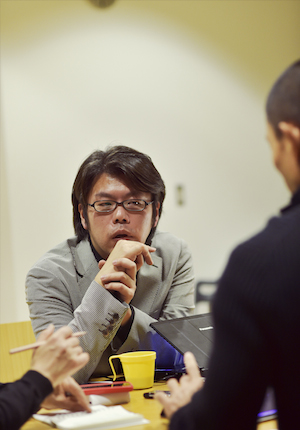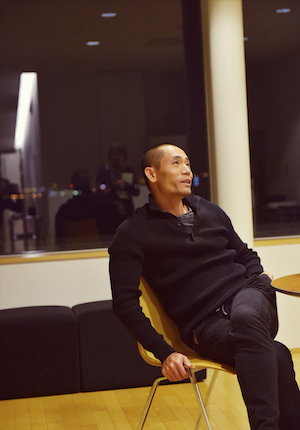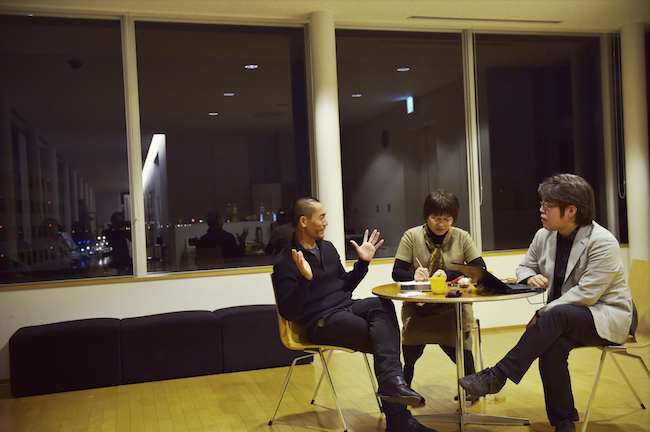International Cooperation and "Asia"
- The lighting designer for Black & White is Asako Miura from Japan. Your crews are from various countries. Are you interested in working with an international team?
Pichet: Of course I am, because I don't have friends in Thailand (laughs).
- That may be one of the reasons (laughs), but what is the advantage of an international creation team?
Pichet: I am attracted to people who haven't learned about Thai traditional dance and culture. The fact that they don't understand it means they can convert it into something new. They can create new things, and they can offer me new knowledge and methodologies. Thanks to them, I have been able to do things that I hadn't had enough courage to do, while people who are familiar with Thai classical dance and traditional culture cannot help being resistant to new things. I thought the same when I met Wu Na, who played music for Black & White. Wu Na uses a Chinese instrument called guqin that has only five strings, and when it was combined with Thai dance, something new immediately emerged. Khon is usually combined with percussions, not stringed instruments. So a new sensation was created, and the movements also changed.
- In such countries as South Korea or Singapore, there has been a lot of interest in the possibility of international co-production in Asia. What do you think of that?
Pichet: Honestly, I don't quite understand why they are interested in the "Asian" framework... If you draw a line there and give financial priority to Asian co-production, won't the "West" and "Asia" compete? Art is embedded in economy nowadays, which involves various issues, and I wonder what is going on. I had worked with Jérôme Bel, but for the rest, I have been working with various Asian artists.
- I think Asian people's attention had inclined to the West too much, and eventually they became ignorant about Asia, even a neighboring country. I suppose there has recently been counteraction to that and they are seeking for different possibilities.

Pichet: For instance, roughly speaking, Thailand, Laos and Cambodia are very similar, and were almost like the same one country about 1,000 years ago. I am not interested in working with people in these countries because we are too close. Ways of thinking and physical characteristics are too similar. Some people may say that the similarity works though. When you say Asian cooperation, you need to think of each country's characteristics. Thailand, Indonesia, Cambodia and India are very similar in physical trainings and techniques. Artists in these countries create using traditional performing arts as their material. In comparison to that, the ways Japanese artists use their bodies are very different from other Asian countries. There is little relevance to traditional performing arts such as noh and kabuki, and their physical techniques are totally new. Hong Kong and Taiwan are very much influenced by the U.S. In South Korea there are modern dance and entertainment. This is how I classify Asian countries, and the definitions of "Asia" vary.
- I think so too. There isn't such thing as "the characteristic of Asia."
Pichet: Well, I think there is. In Europe, artistic forms are mostly identical in any country, but in Asia, there are traditional performing arts, and there are modern things in contrast to them. You can imagine a passage from the traditional to the modern there. In that sense, the four countries that I mentioned are very traditional, and Japan and South Korea are very modern. Hong Kong, Singapore and Taiwan are a bit deviating. Europe appears to me as a homogeneous mass, while Asia is not homogeneous although countries are connected.
- What does the word "modern" mean to you?
Pichet: I guess what I think "modern art" is about is that the society is democratic, the ways of thinking are liberal, the techniques of physical movements reflect the society, and the society has an interest in physical movements. By the way, who is the female dancer who performed naked for the first time in Japan?
- Probably a butoh dancer, I guess.
Pichet: How many years ago?
- I don't know exactly, but probably some 40 years ago.
Pichet: Nobody has done that in Thailand, Laos, Cambodia and Indonesia yet: you clearly see here the difference in the body in traditional performing arts and the body in contemporary art.

Future Activities
- What are you working on now?
Pichet: I'm working on a new piece. For instance, I asked ten people, whose backgrounds are different, questions about death, life and beauty in my presentation in TPAM2015 today. What is death in the engineering world? What is life? What is beauty? What are they in the accounting world? That's the theme I am interested in now.
- Then Khon as your background is not really relevant anymore?
Pichet: It is relevant in the end, but at this stage of research, I'm working on socially tangible matters. The piece is about death, life and beauty. Human's life relates to death even though we do not talk about it. I want to show that death is beautiful. I am looking for the way to portray death and its beauty on stage by using the dance art form and the inspiration of Phi Ta Khon Festival. The origins of this the festival are traditionally ascribed to a story of the Vessantara Jataka in which the Buddha in one of his past lives as a prince made a long journey and was presumed dead. The celebrations on his return were so raucous as to wake the dead. In Phi Ta Khon festival, people in the local area of Loei province (northeast of Thailand) gather together to celebrate the event and dance in folk style. The dance is so raw, real and spiritually powerful. The dance techniques of my new piece will be similar to my previous work "Black & White", that the dance movements and energy were developed from Khon dance techniques. On the other hand, artistic part, the dancers have to present their creativities through their movements like what they do in another work "Tam Kai" when each of them can present their creativities and individuality with freedom of movement. There are 2 parts of the performance.
Life: represents freedom of each dancer in term of mind, body and movements as individual person who is different and unique.
Death: the unity and harmony of movement and energy.
- The individual and the traditional do not contradict but coexist in your work. ― Is that piece the main focus of your activity now?
Pichet: Yes. I have been simultaneously involved in the two processes: the traditional and the modern. The story and characters are traditional, but the narrative and presentation are modern. And the material is interviews with ordinary people. I think we can extend the range of audience by using thought of ordinary people.
- Is that piece the main focus of your activity now?
Pichet: I have another idea of collaboration with cooks. I want to question what the tastes of movements are. When you see a movement, you feel the energy and power, and the dancer's body emits smell. But you don't know the taste of the movement. What does it taste like? I want to know, and I want to tell audience, what it tastes like. So I want to work with cooks. For example, I show a movement to a cook, and he conceives its taste and communicates it to audience.
- It sounds like what is called "rasa (taste)" in Indian classical aesthetics. In India, traditionally, music or dance is described as "spicy" or "sweet."
Pichet: Yes.
- We receive stimulations about the new as well as about the old from your pieces. Audience are simultaneously led to the two vectors.
Pichet: I think that is the strength of Asia. What is strong in Asian people should be the fact that they have firm traditional cultures.
- By the way, what do you think about butoh?
Pichet: I think it is a big achievement. They created a new language, and gave it three-dimensional meanings. It is also connected to traditional culture.
- I think their relation to tradition is a bit different from contemporary Asian artists... I mean butoh was created by Japanese people who lived in the post-war era, where they weren't able to be proud of traditional culture anymore.
Pichet: Regardless of whether you like it or not, I simply think that it is a good thing to create something new. You can create a new knowledge no matter how you like or dislike it. I don't like Thai dance either. I create my pieces because I don't like Thai dance (laughs). I don't like it, although eventually I have been promoting it. I was taught that butoh was influenced by noh at my university. Isn't that true? Anyway, I think it was an achievement.
- Japanese people can't be that clear about it.
Pichet: Why?
- Because butoh didn't develop on traditional performing arts but showed it as "the ruins."
Pichet: Do you mean it wasn't connected but disconnected itself?
- So it isn't as positive as contemporary Asian artists are. It isn't represented as a linear development.
Pichet: I see. But I suppose that the idea also comes from a specific culture.
- Thank you very much for taking time. I look forward to the new work.

[February 11, 2015, at Kanagawa Arts Theatre]
Interviewer: Daisuke Muto
An associate professor at the Faculty of Literature, Gunma Prefectural Women's University and a dance critic. Studies the global history of dance with a focus on Asia in the 20th century and develops a choreographic theory based on the study. A coauthor of RELAY: Theories in Motion (Palgrave, 2016, forthcoming), History of Ballet and Dance (Heibonsha, 2012), and among his papers is "Kazuo Ohno's 1980" (Bulletin of Gunma Prefectural Women's University, No.33, 2012). His choreographic work Surely It Comes About was premiered in 2013.
Translator: Miwa Takasugi






